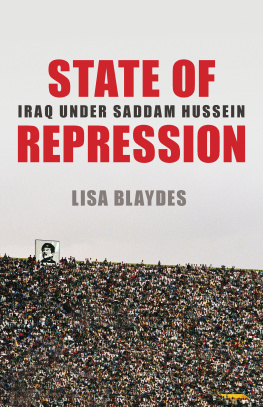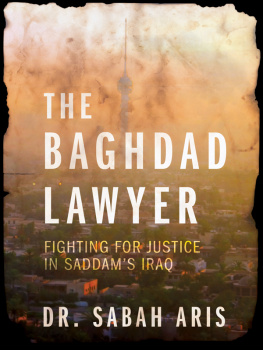STATE OF REPRESSION
STATE OF REPRESSION
Iraq under Saddam Hussein
LISA BLAYDES
PRINCETON UNIVERSITY PRESS
Princeton and Oxford
Copyright 2018 by Princeton University Press
Requests for permission to reproduce material from this work should be sent to Permissions, Princeton University Press
Published by Princeton University Press,
41 William Street, Princeton, New Jersey 08540
In the United Kingdom: Princeton University Press,
6 Oxford Street, Woodstock, Oxfordshire OX20 1TR
press.princeton.edu
Jacket image: Baghdad, Iraq, 2002
Photography by Eric Bouvet. Courtesy of Getty Images.
All Rights Reserved
Library of Congress Control Number: 2018936379
ISBN 978-0-691-18027-4
British Library Cataloging-in-Publication Data is available
This book has been composed in Garamond Premier Pro and Scala Sans
Printed on acid-free paper.
Typeset by Nova Techset Pvt Ltd, Bangalore, India
Printed in the United States of America
1 3 5 7 9 10 8 6 4 2
FOR JOSH
CONTENTS
FIGURES AND TABLES
PREFACE
Some readers of this text will see it as two books in one. While I have sought to make my core contribution the promulgation of a new theory for how political identities are reinforced through authoritarian regime repression, a second narrative lurks just beneath the language of theories, hypotheses, and empirical tests. The shadow book is one about the everyday lived experience of individuals managing the high-stakes political world of autocratic Iraq during the dictatorship of Saddam Hussein.
The qualitative stories embedded in this book appear as evidence for assumptions, empirical implications of hypotheses, and as tests for my theoretical expectations. These narratives reflect the complex interactions between a regime and a citizenry, both struggling for survival. Some of the qualitative accounts are mundane, focused on the ways that Iraqis sought opportunities for social, educational, or political advancement. Other narrative accounts are more profound in their implications. In all cases, the Bathist regimes aspirations for political hegemony were thwarted by a lumpiness in the regimes ability to monitor its own society and, eventually, declining state capacity.
When fiscal conditions were favorablelike during the 1970s after nationalization of the oil industrythe Bathist regime managed emerging political threats with relative ease. The 1980s and 1990s, however, brought an entirely new set of challenges, first with the tremendously costly Iran-Iraq War and, later, with the humanitarian catastrophe of the international economic embargo. Understanding how the Bathist regime managed Iraqi politics during good economic times is not as puzzling as comprehending how the regime managed domestic threats during tough times. The burdens associated with war and sanctions increased individual acts of political non-compliance. A primary argument of this book is that the way citizens were punished in response to these behaviors forged and reinforced meaningful, actionable forms of political identity.
Communities that were culturally distant from the Bathist regime were difficult to penetrate from a monitoring and intelligence-gathering perspective. When the Bathists could not accurately distinguish between those individuals who had complied with and those who had resisted regime dictates, punishment was meted out imprecisely. In other words, the regime meted out punishment based on the precision of its intelligence. Communities that were culturally distant from the Bathists presented a monitoring challenge and group-level punishment reinforced the salience of group identities. Highly penetrated communities that were culturally close to the Bathists were punished with a high degree of accuracy; the result was political atomization for members of those communities.
The struggle to make the Iraqi population legible to the Bathists was a core regime pursuit. While countries across the Middle East were seeking to stem growing urbanization and the associated expansion of urban slums, the Bathists were clearing the Kurdish countryside, moving tens of thousands of Iraqi Kurds into cities to increase the regimes ability to monitor and penetrate northern society. One of the richest sources of data used in this project emerges as a response to the regimes failure to accurately read Iraqi society. Prior to the regime-shaking 1991 Uprisings, the regime collected only basic data about Iraqi high school students, like name, address, and political orientation. After 1991, however, the regime significantly expanded information collection with the goal of identifying which young people and, by association, which families were politically trustworthy. In both the example of the creation of Kurdish urban settlements and the enhanced information collection on high school students, separating out good from bad citizens was a preoccupation of the regime. The documents that comprise the empirical content of this project are themselves a manifestation of the bureaucratization of autocracy that the Bathist regime epitomizes.
How does the Bathist regime in Iraq compare to other authoritarian regimes? And how broadly might the lessons of this book be applied? The idea that group-level punishment reinforces communal identity has wide applicability. In the democratic context, there are countless examples of cases where governments or local authorities criminalize entire communities because investigators did not possess or invest in the capacity to differentiate between law-abiding residents from law breakers. During World War II, Japanese Americans were less legible to the US government than German and Italian Americans; as a result Japanese Americans were collectively imprisoned My arguments suggest that a shared sense of salient identity would emerge among residents of South-Central Los Angeles as a result of the way the area was repressed by a state that could not effectively discriminate among individual actors within that population. This period of collective repression spawned new forms of anti-system artistic expression, and in 1992 South-Central Los Angeles was the epicenter for major ethnic riots.
While my arguments might be applied to democratic contexts, the theoretical implications of the book are particularly apt for the study of political behavior in autocracies. In countries where a dictator rules a homogeneous population that is culturally similar to the ruling clique, effective monitoring of the population means citizens are constantly worried about members of their own social network who may inform on them. The result is a relatively low degree of interpersonal trust between individuals and no reinforcement of a salient identity around which political mobilization might organize. For example, North Korea is a relatively homogenous society where the ruling elite comes from the majority cultural group. There are few barriers to intelligence gathering within the population and the regime has the capability to mete out punishment with precision. North Korean prison camps are full of would-be defectors and others who ran afoul of the regime for any variety of offenses.
Collective punishment heightens group identity, even when such identities were not particularly salient for group members in advance of the repression. Stalins collective repression of Ukrainian peoples during the 1930s is thought to have given birth to Ukrainian national consciousness. of Bedouin identity. Examples abound in the Middle East and beyond. And while this project cannot account for how certain types of identity came to exist as social constructs in the first place, I do seek to explain how and why identities become emboldened and reinforced.
Finally, while scholars have long described state repressionincluding harassment, surveillance, arrests, and mass killingsas a key lever of political power, the study of repression has developed unevenly with core concepts left undertheorized. Within the study of authoritarian regimes, we also know much more about the politics of cooptation when compared to our understanding of state repression. What explains the use of repression and the deployment of state violence? And how does repression impact citizenries? There is a dearth of scholarship on these subjects relative to studies focused on either interstate conflict or political patronage. This book is the product of my efforts to dig a little deeper into the causes and consequences of repression as well as to understand how repression fits into a broader conceptualization of power in autocratic regimes.
Next page











